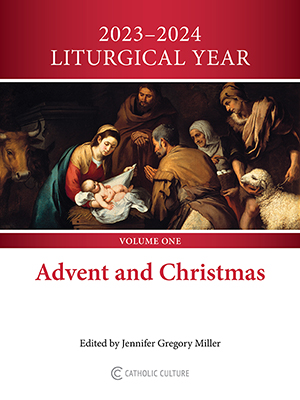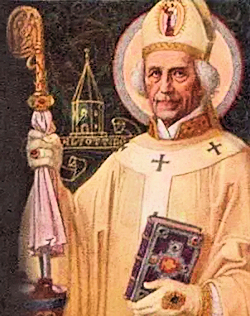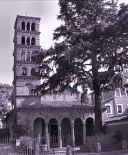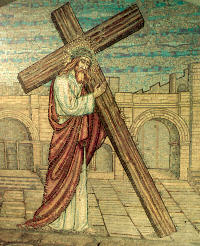Lent: March 27th
Friday of the Fifth Week of Lent
Other Commemorations: St. Rupert, Bishop (RM)
Free eBook:

|
| Free eBook: Liturgical Year 2023-2024, Vol. 1 |
» Enjoy our Liturgical Seasons series of e-books!
But one of them, Caiaphas, who was high priest that year, said to them, "You know nothing at all; you do not understand that it is expedient for you that one man should die for the people, and that the whole nation should not perish." He did not say this of his own accord, but being high priest that year he prophesied that Jesus should die for the nation, and not for the nation only, but to gather into one the children of God who are scattered abroad (Jn 11:49-52).
According to the 1962 Missal of St. John XXIII the Extraordinary Form of the Roman Rite, today is the feast of St. John Damascene. His feast in the Ordinary Form of the Roman Rite is celebrated on December 4.
Meditation - Christ's Last Days
Every person who loves Christ now tries his best to remain close to his suffering Savior during the last hours of His earthly life. The liturgy places us directly in the midst of the recorded events and expects us to participate. During these next days, therefore, we will traverse each road with Jesus.
Yesterday (Friday) He came with His disciples from the desert village of Ephrem to Jericho. When near the Jordan we heard from His lips the third prophecy of the crucifixion. Then Salome approached with her two sons, John and James, and begged important positions for them in the coming kingdom. This gave Jesus the opportunity to proclaim His wonderful teaching on humility. We stand close and listen.
The Lord enters Jericho. I am Zacheus, the chief publican, the little man who wants to see the Messiah from a tree. He looks up to me and says, "Today salvation has come to your house!" He stays two nights with me, a despised publican!
Over the Sabbath Jesus remains in Jericho. The next day (Sunday) He starts for Jerusalem at the head of a lordly caravan. Along the road there sits a blind beggar. It is I, again. "Jesus, Son of David, have mercy on me!" He heals my eyes, I see, I am enlightened!
In procession we pass through Jericho's inhospitable ravines up to Jerusalem. Night intervenes and Jesus stops at Bethany. He is joyously welcomed by Martha and Mary. Am I an active Martha or a meditating Mary? Possibly it was on this Sunday evening that the memorable meal took place when, with Lazarus present and Martha as hostess, Mary poured out the costly ointment for Jesus' burial. It was the act which estranged Judas completely from his Master.
In solemn procession on Monday afternoon the King of Israel comes to the top of Olivet, weeps over Jerusalem, and then continues on to the temple. We feel ourselves part of this festive procession, waving palms in our hands. We accompany our King and watch Him drive the money-changers out of His Father's house. Tuesday morning He returns with His disciples and while crossing Mt. Olivet curses the unfruitful fig tree, a figure of the Jewish people. This barren tree is likewise a warning for us.
Verbal encounters with the Jews take place in the temple courtyard until Wednesday afternoon when Christ hurls His eightfold curse upon Pharisee and Jew, and leaves the temple forever. With His disciples He then proceeds to the Mount of Olives and delivers His powerful discourse on the end of the world and the destruction of Jerusalem. Present in spirit we hear this sermon and take to heart His final admonition, "Be vigilant!" Meanwhile Judas has left the circle of disciples and offers his assistance to the chief priests.
Thursday morning Christ sends Peter and John from Bethany into the city to make the needed preparation for the Passover meal. As evening falls He bids farewell to His mother and His friends and goes with His apostles to the Upper Room in Jerusalem for His "Last Supper" with them.—In mind and in heart we will follow our Blessed Lord closely during these sacred days of Holy Week.

The Station, at Rome, is in the church of St. Stephen on Monte Celio. This church of the great proto-martyr was chosen as the place where the faithful were to assemble on the Friday of Passion week.
St. Rupert of Salzburg
 St. Rupert was the first bishop of Salzburg, who, in some legends, is credited with giving the city its name.
St. Rupert was the first bishop of Salzburg, who, in some legends, is credited with giving the city its name.
Rupert was born in the late seventh century, to a part of the French imperial family. Little is known about his early life, but, like many sons of noblemen, entered the clergy. Rupert was elected bishop of Worms, a German city that was an important seat of power in the Carolingian dynasty.
At first, Rupert's flock welcomed his presence as a caring and faithful bishop. All too soon, however, the relationship between Rupert and the people of Worms soured. Conveniently, a Bavarian Duke, Theodo, asked for Rupert to come south to his palace at Regensburg to come spread Christianity to the diverse tribes he ruled over in Bavaria.
Rupert is often credited with baptizing Theodo, and officially welcoming him into the Church, as the seventeenth-century painting to the left depicts. And with Theodo's blessing, he began his missionary work among the Bavarian tribes.
Rupert found that Bavaria was still, in many ways, truly a wilderness with lots of outbreaks of violence. Thus, Rupert traveled to an old ruined Roman city and renamed it "Salzburg." Rupert founded and rebuilt several different monasteries in the area and lay the foundations of the Salzburg Cathedral. Where, a little over a thousand years later, Wolfgang Amadeus Mozart was baptized.
Rupert died in 710, and there's some dispute whether he had returned back to Worms at the time of his death or whether he died in Salzburg. His successor, Bishop Vergilius of Salzburg, interred his remains in the newly-finished Salzburg Cathedral in 774.
Rupert is known as the "Apostle to the Bavarians" and is a patron saint of Salzburg, Austria, and salt miners.
—Excerpted from Faith ND
Patronage: city of Salzburg, Austria; province of Salzburg, Austria; archdiocese of Salzburg; salt miners
Symbols and Representation: man holding a container of salt (refers to Salzburg and the salt mining there); wearing clerical clothes including mitre; holding a crosier
Highlights and Things to Do:
- Read more about St. Rupert:
- Read about St. Rupert's Fair, the biggest traditional fair in Europe.
- See the Stift St. Peter -- St. Peter's Abby that St. Rupert restored and lived.
- St. Rupert's remains are located at the Salzburg Cathedral at the Volksaltar.

Monday of the Fifth Week of Lent
Station with San Crisogono in Trastevere (St. Chrysogonus in Trastevere):
The Station, at Rome, is in the church of St. Chrysogonus, one of the most celebrated martyrs of the Church of Rome. His name is inserted in the Canon of the Mass. The church was probably built in the 4th century under Pope Sylvester I and one of the tituli, the first parish churches of Rome, known as the Titulus Chrysogoni.
For more on San Crisogono in Trastevere, see:
For further information on the Station Churches, see The Stational Church.







